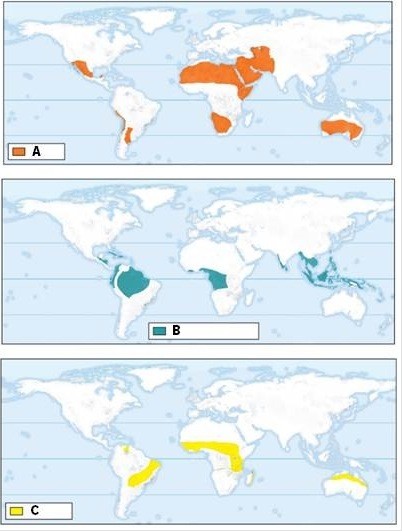Identify the biomes labeled A, B, and C in the maps. Describe the general locations and climate in each biome.
What will be an ideal response?
A. Deserts: Deserts are usually found about 30° at latitudes in both the Northern and Southern Hemispheres. They are characterized by hot days and cold nights with very little rain and moisture.
B. Tropical rain forests: Tropical rain forests are found in parts of Central and South America, Africa, and the Indo-Malayan region near the equator. The weather is always warm and rainfall is plentiful.
C. Savannas: The largest savannas are in central and southern Africa, South America, and Australia. Savannas occur in regions where a relatively cool dry season is followed by a hot, rainy season.
You might also like to view...
The _____ forms of the electron carriers NAD+/NADH and FADH/FADH2 have high potential energy
A. oxidized B. reduced C. phosphorylated D. carboxylated E. None of the answer options is correct.
During parturtition, mechanical pressure
caused by the movement of the fetus through the uterus causes the release of ___ from the ___.
a. HCG---hypothalamus b. oxytocin---posterior pituitary c. oxytocin---hypothalamus d. HCG---posterior pituitary e. oxytocin---adrenal cortex
Transgenic organisms
A) contain cells from other organisms. B) contain genetically engineered microbes. C) are the same as clones. D) contain genes from other organisms. E) have genomes that have been sequenced completely.
During which of the following stages do cells of identical genetic makeup become structurally and functionally different from one another according to the genetically controlled developmental program of the species:
a. cleavage b. cell differentiation c. morphogenesis d. metamorphosis e. ovulation